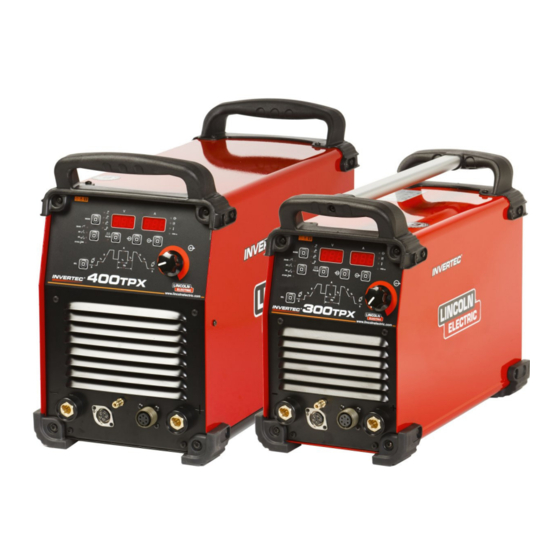
Advertisement
Quick Links
Advertisement

Summarization of Contents
Safety Precautions
Hazard Warnings and Precautions
Details critical safety warnings regarding electric shock, fumes, arc rays, sparks, and hot materials.
Installation and Operator Instructions
Location and Environment
Guidelines for optimal machine placement and operation in various environmental conditions for long life and reliability.
Input Supply Connection
Instructions for connecting the machine to the power supply, ensuring correct voltage, phase, frequency, and grounding.
Operation and Controls
Welding Connections and Features
Details on TIG welding connections, water cooling, remote control, and Green Mode operation.
Front Panel Indicators and Controls
Explains front panel LEDs (Power ON, Remote, Thermal, VRD) and key control elements like the Output Current Knob.
Machine Controls
Mode and Trigger Selection
Details on using Mode and Trigger pushbuttons for selecting welding modes and sequences.
Parameter Adjustment and Display
Explains SEL pushbutton, Memory buttons, Pulsing mode, Output Current Knob, and V&A displays for parameter control.
Welding Modes and Operation
Display Information
Explains characters displayed on the V&A meters for parameters, program records, and error codes.
Stick Welding (SMAW)
Guide to selecting and performing Stick welding, including Hot Start and Anti-Sticking features.
Lift TIG Welding (GTAW)
Instructions for selecting and performing Lift TIG welding, including arc initiation and process details.
Advanced TIG Welding
HF TIG Welding
Details on HF TIG welding, including arc initiation without electrode contact and arc start strength adjustment.
Spot TIG Welding
Instructions for Spot TIG welding, focusing on tacking or welding thin materials with fixed time control.
TIG Welding Sequence Parameters
Explains parameters like Pre-flow, Start Current, Upslope, Set Current, Duty Cycle, Frequency, Background, Downslope, Crater, and Postflow.
TIG Trigger Sequence Operation
2-Step Trigger Sequence
Step-by-step guide for using the 2-step trigger sequence for TIG welding without restart functionality.
2-Step Trigger Sequence with Restart
Explains the 2-step TIG trigger sequence with the added functionality of a restart option.
Advanced TIG Trigger Sequences
4-Step Trigger Sequence
Detailed steps for operating the 4-step TIG trigger sequence without the restart function.
4-Step Trigger Sequence with Restart
Guide to the 4-step TIG trigger sequence, including the functionality of the restart option.
Advanced Setup and Features
Bi-Level Trigger Sequence
Instructions for using the Bi-Level trigger sequence for welding with two current levels (A1 and A2).
Setup Menu Navigation
Guide on how to enter, navigate, change settings, and exit the machine's setup menu.
Troubleshooting and Maintenance
Error Codes and Troubleshooting
Information on interpreting error codes, troubleshooting common faults, and seeking service.
Maintenance Guidelines
Recommendations for routine maintenance, cleaning, and safety precautions during service.
Parameter and Program Configuration
Factory Configuration Parameters
Details on pre-set parameters for Preflow, Start Current, Upslope, Set Current, Duty Cycle, Frequency, Background, Downslope, Crater, and Postflow.
Stick Welding Programs
Description of SOFT Stick and CRISP Stick programs and user-adjustable parameters.
TIG Spot Welding Configuration
Details on TIG Spot welding setup, including trigger settings and spot current.
Electromagnetic Compatibility (EMC)
EMC Design and Operation
Information on the machine's EMC compliance, industrial area operation, and potential disturbances.
Reducing Electromagnetic Emissions
Guidelines and precautions to minimize electromagnetic interference generated by the welding machine.
Technical Specifications
Input and Output Ratings
Details on input power, voltage, output current, duty cycle, and voltage ranges for the welding machines.
Physical and Electrical Requirements
Specifies recommended cables, fuses, physical dimensions, operating temperatures, and WEEE disposal.
Spare Parts Information
Instructions on how to identify and order spare parts for the welding equipment.
Electrical Schematic and Accessories
Suggested Accessories List
A comprehensive list of optional accessories available for the INVERTEC 300TPX and 400TPX welding machines.















Need help?
Do you have a question about the Invertec 400TPX and is the answer not in the manual?
Questions and answers